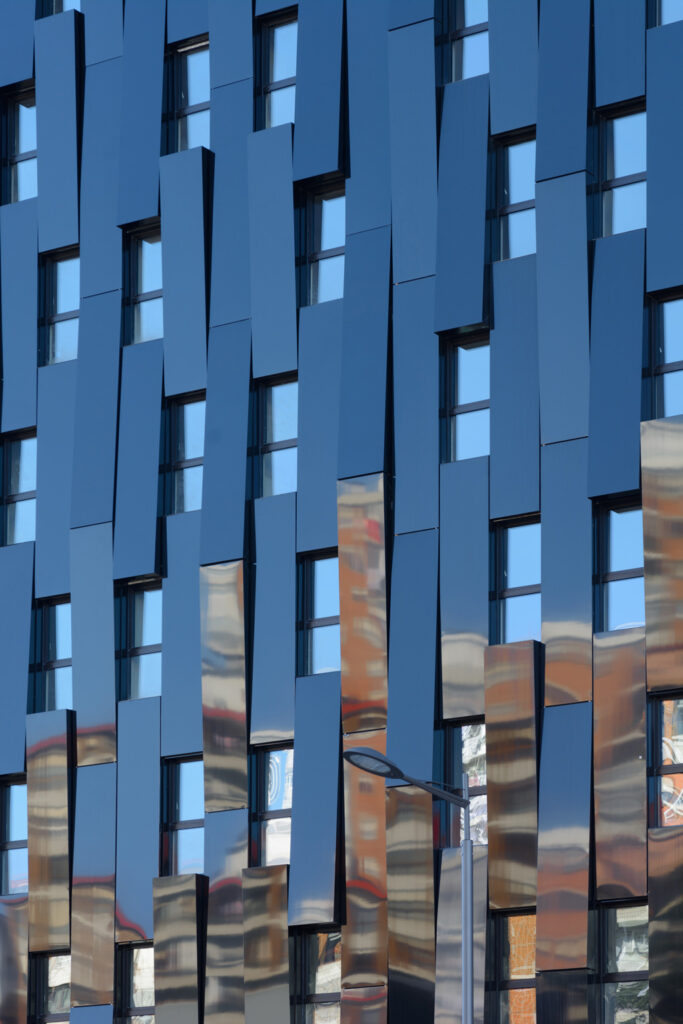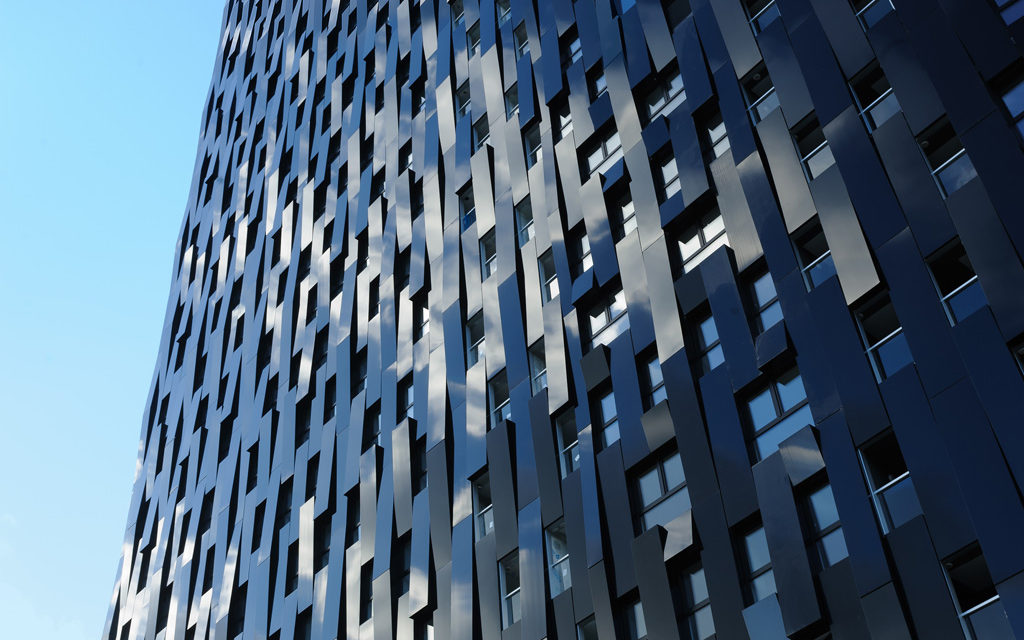88-metre high building world’s tallest Passive House – certification ensures quality
The developers and architects had set very high goals. With the Bolueta building they wanted to set a new Passive House record and at the same time ensure the quality of the building through certification. The project participants have successfully achieved both objectives. With a height of 88 metres, Bolueta in the Spanish city of Bilbao is now the tallest Passive House building in the world. The recently issued certificate is proof of its highly energy-efficient Passive House Standard construction. The latest publication by the Passive House Institute appropriately relates to this topic: The Building Certification Guide.
The Bolueta high-rise building is identically named like the district of the city of Bilbao in northern Spain and is situated close to the busy railway station Bolueta. With a height of 88 metres and its conspicuous shiny black façade, the building towers over the neighbourhood. It contains a total of 32 storeys, 28 of which are above ground, and thus visible.

Photo: © VArquitectos
Optimised construction
The Spanish architect Germán Velázquez optimised the design of the Bolueta construction project until it achieved the highly energy efficient Passive House Standard. An adjacent nine-storey building with 63 apartments for social housing is also part of the project.
Within budget
The challenge was to keep within the budget and use traditional materials, the architect explained. “Now that Bolueta is complete, there are no excuses anymore: it is possible to realise such a project in Bolueta, and it is just as possible to realise one almost anywhere out there,” says Velázquez.

Photo: © VArquitectos
Basque Government commits to energy-efficiency
It took two and a half years for Bolueta to be completed. The Basque Government and its public property development company Visesa are the owners of the Bolueta project, which also includes the nine-storey adjacent building in addition to the high-rise. All 108 apartments of the high-rise have already been sold and residents are moving in now. The 63 apartments in the adjacent building will be rented as social housing. The cost for Bolueta, which includes 171 apartments in total, amounts to approximately 12.5 million euros.
Certificate presented in Munich
A building certificate authenticating the attainment of Passive House Standard for Bolueta was also presented during the International Passive House Conference in Munich. With this highly energy efficient standard, the residents save heating costs in the winter and enjoy a comfortably cool home in the summer. In addition, a controlled home ventilation system ensures a pleasant and healthy indoor climate.

At the Passive House Conference in Munich, the Project participants were awarded the Passive House certificate by Javier Flóres. Photo: © Passive House Institute
Energy efficient high-rise buildings
“All over the world people are now recognising that the advantages of the Passive House Standard also work for high-rise buildings. Besides Bolueta in Spain, many large projects are currently being planned or are already under construction, particularly in the USA, Canada and China,” explains Zeno Bastian. Bastian is in charge of building certification at the Passive House Institute. With its height of 88 metres, Bolueta is currently the highest Passive House building in the world. It is two metres taller than the Passive House students’ residence at Cornell Tech in Manhattan, New York which opened to residents in 2017.
Pioneers in Freiburg and Vienna
Among the first Passive House high-rise buildings are a 16-storey building in Bugginger Strasse in Freiburg retrofitted to the Passive House Standard in 2011, and the Raiffeisen Tower in Vienna. The latter was built on the premises of the former OPEC headquarters and started operations in 2013. The 78-metre-tall building provides space for about 900 offices. In Spain, the Basque Government is constructing another Passive House high-rise right next to Bolueta. Although this will be smaller with 21 storeys, it will be more extensive than the first building and will have 190 apartments in total. Ten storeys of the second building, which will also be certified, have already been completed.
Black as coal
The façade of the tallest Passive House high-rise in Bilbao is also striking. The surrounding buildings and countryside are reflected in the black, glossy surfaces. “The project has a significantly “lighter” effect as a result, and the black colour symbolises the industrial past of the city. It is a tribute to the two-and-a-half century’s old heavily coal-based industry,” explains Velázquez. The second tower will be grey in colour to allude to the steel that was once produced in Bolueta. The architect has also designed a health centre to Passive House Standard in the Basque region of Navarra.

The black façade of Bolueta recalls the industrial past of the city. Photo: © VArquitectos
A concise manual
The Passive House Institute has published a manual for building certification. Certification means extensive quality assurance in order to achieve high energy savings and optimal living comfort.
“The manual offers a quick overview of the advantages of Passive House certification and its procedure, and also contains detailed explanations regarding all the documents which must be submitted for certification. That’s another step to facilitate the certification even more for all those involved,” says Zeno Bastian of the Passive House Institute. The Building Certification Guide can be downloaded free from the Passive House Institute website at www.passivehouse.com.
About Passive House
Passive House
Passive House buildings feature a high quality of thermal insulation, triple-glazed windows, and an airtight building envelope. In winter, heat recovery by the ventilation system introduces preheated air intro the building. Five basic Passive House principles ensure that these highly energy efficient buildings can do without a classic heating system. Such buildings are called “passive houses” because a major share of their low heating demand is met through “passive” sources such as solar radiation or the heat generated from occupants and technical appliances. A Passive House thus consumes about 90 percent less heating energy than an existing building and 75 percent less energy than an average new construction.
Passive House and NZEB
The Passive House Standard already meets the requirements of the European Union for Nearly Zero Energy Buildings. According to the European Buildings Directive EPBD, member states must specify the requirements for Nearly Zero Energy Buildings (nZEB) in their national building regulations. These will come into effect on 1.12.2018 for public buildings and on 31.12.2020 for all other buildings.
Pioneer project
The first Passive House in the world was built in Darmstadt-Kranichstein (Germany) 27 years ago by four private homeowners. Dr Wolfgang Feist was one of them. Ever since they moved in with their families in 1991, these terraced houses have been regarded as a pioneer project for the Passive House Standard. 25 years later, after extensive technical testing, building physicists attested to the unimpaired functioning of the first Passive House and its unchanged low heating energy consumption. With its newly installed photovoltaic system, the world’s first Passive House now utilises renewable energy and received the Passive House Plus certificate for this reason.
Passive House and renewable energy
The Passive House Standard can be combined well with on-site renewable energy generation. Since April 2015, the new building classes “Passive House Plus” and “Passive House Premium” have been available for this supply concept. The first buildings in these two categories have already been certified, including private houses as well as office buildings.
Passive Houses worldwide
Passive Houses buildings for all types of uses now exist everywhere. In addition to residential and office buildings there are also kindergartens and schools, sports halls, swimming pools and factories built as Passive House buildings. The first Passive House hospital in the world is currently being built in Frankfurt am Main, Germany. Interest in Passive House is growing. In view of the consumption of resources in industrialised countries and global warming, Interest in Passive House is growing.
Passive House Institute
The Passive House Institute with its headquarters in Darmstadt, Germany, is an independent research institute for highly efficient use of energy in buildings. The Institute founded by Dr. Wolfgang Feist holds a leading position internationally with regard to research and development in the field of energy efficient construction. Among other things, Dr. Wolfgang Feist received the 2001 DBU Environmental Prize for developing the Passive House concept.
Passive House Conference
The Passive House Institute is the organiser of the International Passive House Conference and the accompanying specialists’ exhibition. The 23rd International Passive House Conference will take place on 21 and 22 September 2019 in Gaobeidian, China. www.passivehouse-conference.org. In addition, on 3 and 4 May 2019 the Passive House Conference “Besser Bauen” (Better Building) will be held in Heidelberg, Germany. www.heidelberg.passivhaustagung.de
Our sincere gratitude to Dr. Wolfgang Feist, founder of the Passive House Institute, and his office, for sharing this article and images with PRISM. The Passive House Institute provides a comprehensive compilation of research on Passive House building and planning, and recommend visiting their website at https://passivehouse.com/ for more information.




